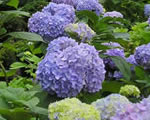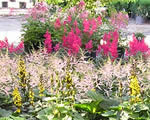
5155
NW 57th Ave
Johnston, Iowa
Click for Directions
Store
Hours
Monday
- Friday
8:00am - 5:00pm
Saturday
8:00am - 4:00pm
|
1. Dig a hole that
is approximately 4-8", for trees, or 2-4", for smaller
potted shrubs and perennials, larger than the the pot all the
way around. Look on the trunk of the tree near the soil level
for the trunk flare (this is the area of the trunk where it begins
to widen below the graft). This is where the soil should come
up to when planting. This area may be slightly below the soil
line so you may need to carefully remove some soil from the top
of the ball in order to get the tree planted at the correct depth
in your yard. Dig the depth of your hole accordingly being careful
not to go too deep. If the soil is loosened in the bottom of the
hole you risk the tree settling. To
get an accurate depth of the hole we recommend placing a rake
handle across the hole, using your spade or a tape measure to
measure the depth of your hole, and comparing it to the height
of the ball. 2. To remove the plant from the pot, lay it on its side. Then pull the plant out. Sometimes it is necessary to press down on the pot to loosen the soil. Do not cut the pot if possible. We recycle pots and we ask our customers to return the pots to us if possible. 3. If roots are circling inside the pot, cut the roots with a knife or spade to help the roots expand beyond the root ball. You will need to do this aproximately 4-6 times from the top of the soil ball to the bottom and a few times on the very bottom of the pot. Do not cut very deep 3\4" is sufficient. 4. Place the plant in the hole and make sure you have it sitting straight in every direction and it is at the correct depth. Once you have the plant straight fill the hole approximately 1/3 full with soil. Then water the soil around the ball and run your spade in several times to help remove any air pockets. 5. Now you can fill the rest of the hole with soil. It is recommended to use the same soil removed from the hole for backfill. In clay soil, using large quantities of black dirt or peat moss can create a bowl effect. The roots will not be able to penetrate the clay soil. Often water will pool in the hole and ultimately kill the plant. Use a spade or shovel to breakup the soil being used as backfill. This will remove air pockets. Make sure the plant is straight. Water again and run your spade in around the ball to remove any remaining air pockets 6. It is not necessary to stake the plant unless it is very loose in the soil. By not staking, the roots will be strengthened. If the plant tips in the hole a few days after planting, water the plant again and push a spade into the ground by the ball and gently pull on the trunk and the spade to set the plant straight again. 7. Place a layer of mulch around the plant, making sure that the mulch only comes up 1" or less on the base of the plant and thickens to at least 3" as it goes away from the plant. Cedar mulch is recommended due to its ability to repel insects and not blow away. Mulch is helpful for keeping moisture around the roots and eliminating competition from the lawn grass. It is recommended that you keep your plants mulched out to the dripline to reduce grass competition and to help your plants grow as fast as possible. |
© Miller Nursery Inc. 2008


